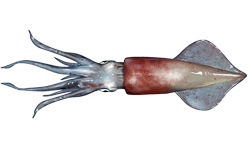Species of squid able to edit their own genes

A Longfish Inshore Squid
April 28, 2020
Doryteuthis pealeii, also known as longfin inshore squid, have the ability to edit their own genetic material. According to Science News, they do so outside of the nucleus of their cells. The longfin inshore squid are a part of the Loliginidae squid family and has a reddish hue varying from deep red to soft pink.
More specifically, they make changes to messenger RNA, or mRNA, strands. Messenger RNA carries the blueprint for building proteins from the nucleus to ribosomes in the cytoplasm of the cell. All living organisms are able to make changes to multiple types of RNA. However, these edits typically take place inside the nucleus. The edited RNA is then transported outside of the nucleus to carry out its desired function.
Joshua Rosenthal, a biologist at the Marine Biological Laboratory in Woods Hole, Massachusetts and fellow researchers wanted to determine how the squids make these edits in nerve cells. They first looked at the location of ADAR2 protein, the mRNA-editing protein, and discovered that it is located in both the cytoplasm and the nucleus. This indicates that editing can occur in both places. They then extracted part of the cytoplasm of the nerve cell with the protein in it and observed it carry out editing of mRNA. This study was done in an attempt to develop a treatment for conditions such as chronic pain by genetically editing cells that create excessive pain signals.
CRISPR is a form of genetic editing involving changing DNA sequences. Developing a technique similar to CRISPR but making edits to the RNA instead of DNA would provide many benefits. The main benefit of RNA-editing opposed to DNA-editing is that when the RNA is broken down after performing its task, the edit is lost, whereas, edits to DNA is permanent. This is helpful in cases where: a temporary fix is needed, and due to it not being permanent, if mistakes occur, the consequences are less severe.






